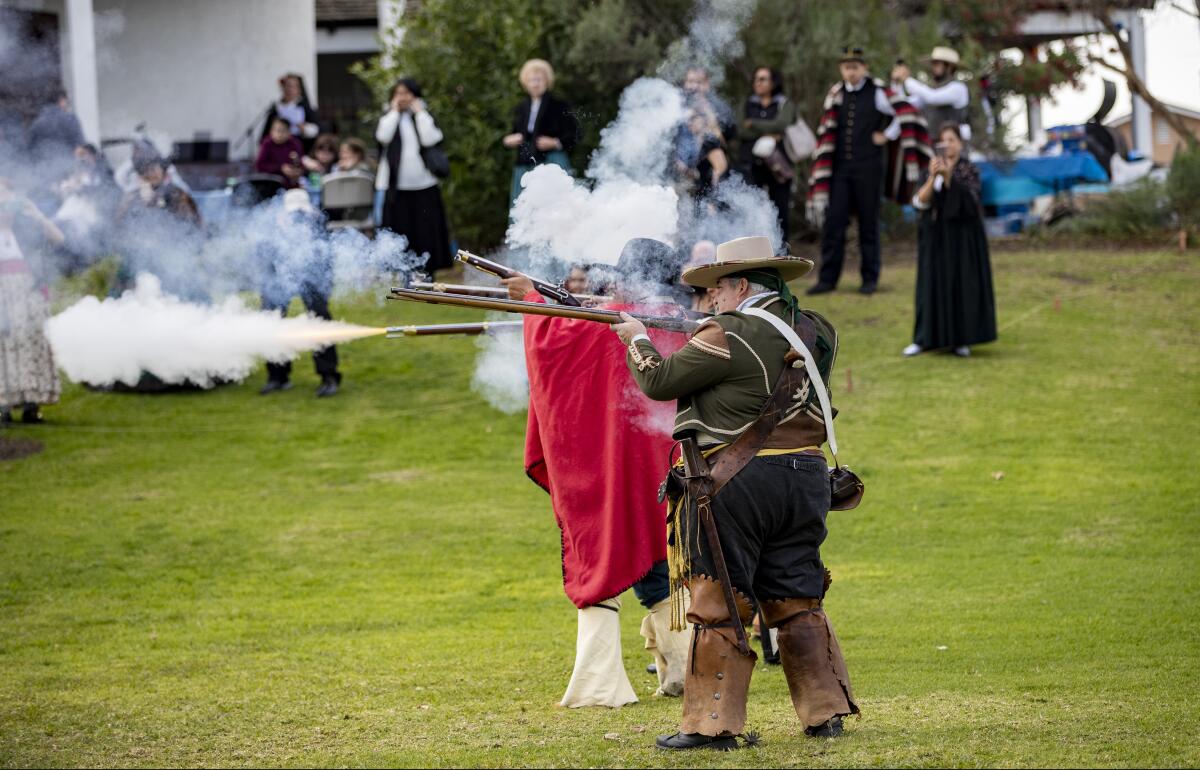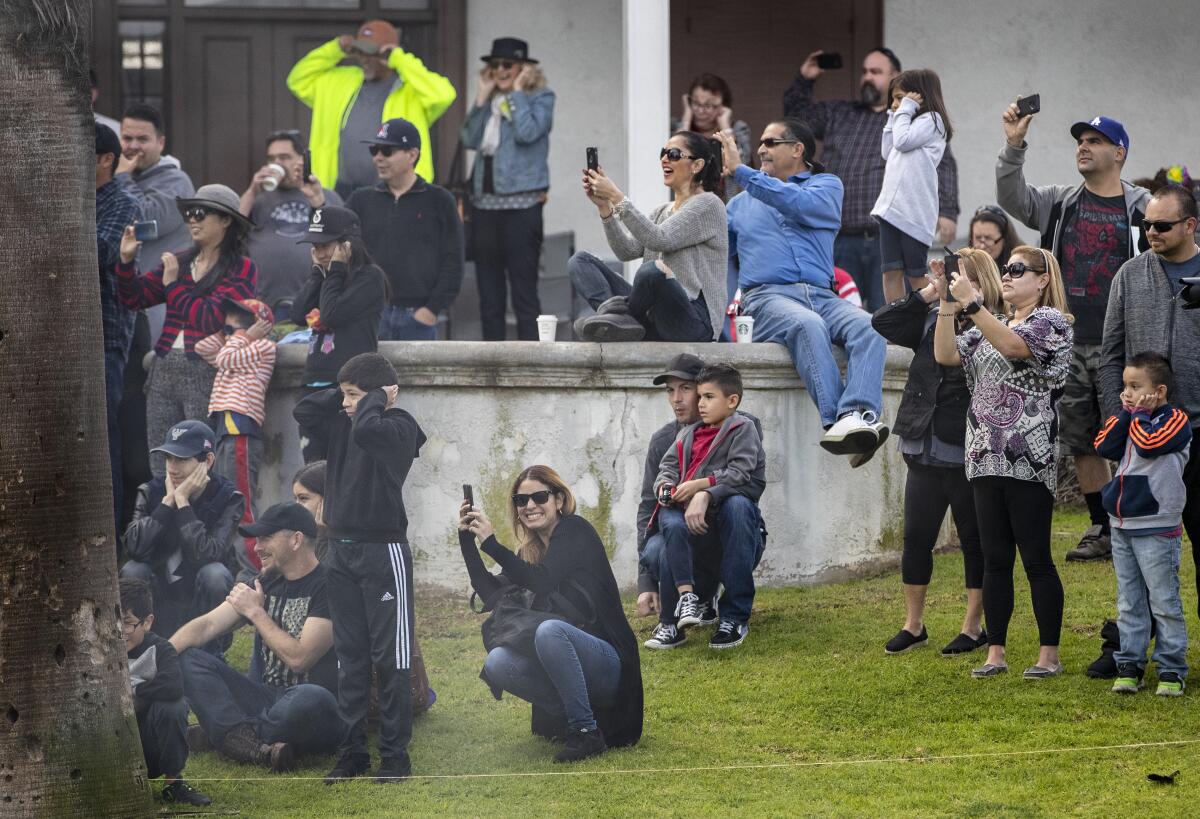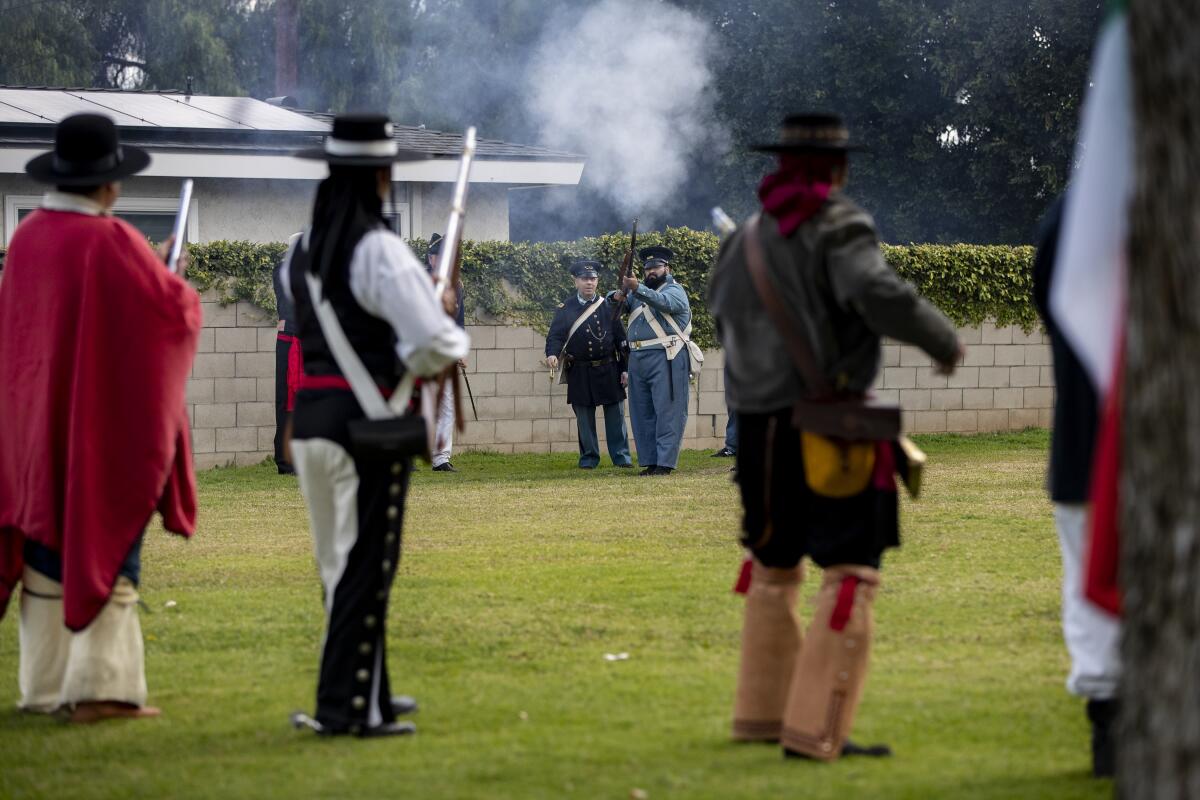In a small field, men reenact an oft-overlooked war that remade the U.S., Mexico and the border

A reenactment of the Battle of Rio San Gabriel performed by members of the Montebello Historical Society.
The insult cut through the air about a minute past high noon on a grassy field where the Mexican and United States soldiers faced off.
“Go back to Boston, gringo!” bellowed Santiago Lobo, a Mexican militiaman and rancher.
Lobo’s verbal volley was aimed at the powder blue-uniformed U.S. Commodore Robert F. Stockton and his men.
Flanked by four of his own fighters, Lobo lined up a clunky and obsolete musket and fired upon one of two columns of American soldiers.
Stockton’s forces remained unscathed and countered with a barrage from superior rifles and pistols while a second group of men loaded a cannon. The larger U.S. force charged and overwhelmed Lobo and his militia.

On a chilly Saturday, the skirmish was a reenactment of the Battle of Rio San Gabriel performed by members of the Montebello Historical Society. The real event, a pivotal battle for control of California in the two-year U.S.-Mexican War, ended on Jan. 8, 1847, with an American victory. The fighting happened on once Mexican land that now constitutes the cities of Pico Rivera, Montebello and Whittier.
The reenactment lasted only about 15 minutes; most of the actors representing the Californio soldiers traced their roots to Mexico. The U.S. soldiers were almost entirely white. Despite the subtext of an often-overlooked war that remade two countries and their fortunes, to a man, the faux combatants tried to steer clear of talk of one of the great conflicts of our time: Debates over U.S.-Mexico border, immigration and, of course, President Trump.
“I’ve been confronted by conservatives who take the position the Mexicans provoked the war, which I don’t believe is true,” said society President Chris Vargas. “The war wasn’t a very popular war, but you don’t have to believe me.”
Steve Clugston, a former curator at the March Field Air Museum in Riverside who played Stockton, said: “The times then, like now, are polarized but we try to represent both sides.”
In that sense, the facsimile of the battle, now in its fourth year at Montebello’s Juan Matias Sanchez Adobe, was a remarkably civil affair in a country where stepping into debates over borders can quickly devolve into the darkest depths of American discourse.

In 2008, some conservatives in the U.S. called for a boycott of Sweden’s Absolut Vodka after it ran an ad in Mexico depicting that country with its former borders and the line: “In an Absolut world.”
For all that it did, the Mexican-American War is a relatively overlooked conflict in American history.
A little more than a year after its defeat, Mexico turned over massive territories including California, Arizona, New Mexico, Nevada, Colorado, Utah and Wyoming in the signing of the Treaty of Guadalupe Hidalgo on Feb. 2, 1848. Mexico also surrendered any further claims to Texas, which had exerted its independence in 1836.
In its wake, a nearly 2,000-mile, scraggly-lined border has fueled angry arguments over immigration (legal and illegal), xenophobia, racism and American identity. The war itself, which was opposed by then congressman Abraham Lincoln and future Civil War general Ulysses S. Grant — who in his 1885 autobiography called it “one of the most unjust ever waged” — comes up less than the next great conflict that followed.
“The Civil War was a dividing point in the nation and helps us understand our nation,” said Rosina Lozano, associate professor of history at Princeton University. “It looms large in the national story but the U.S.-Mexican War has great implications in the U.S. Southwest and can explain the place of Mexican Americans in the nation.”
Lozano also said amendments passed during and immediately following the Civil War overshadowed what happened in the post U.S.-Mexican War.

The 13th, 14th and 15th amendments outlawed slavery, granted citizenship to people “born or naturalized in the United States” and protected voting rights, respectively. Mexico had already abolished slavery in 1829, well before the passage of the 13th Amendment in 1865. Newly conquered non-white Mexican citizens were offered U.S. citizenship in the Treaty of Guadalupe Hidalgo in 1848, ahead of passage of the 14th Amendment in 1866.
Alex Jimenez, 16, a junior at Montebello High School, said not much time is devoted to teaching the Mexican-American War. At home, he opened a slightly torn and taped-together Advanced Placement U.S. history book titled, “The American Pageant: 13th Edition” that has been used at the school since 2007.
“We’re taught in school that this was a push by Easterners to go west and expand the United States to the Pacific Ocean,” the teenager said. “It was the destiny of the country.”
Francisco Balderrama, emeritus professor of Chicano studies/history at Cal State L.A., said the war’s effects have not been emphasized in schools for years.
“This war happened and it’s obviously the bedrock of our society, dividing the border, creating the border that we have today and also the collision course between two nations and two people.”
— Francisco Balderrama, emeritus professor of Chicano Studies/History at Cal State Los Angeles
“This war happened and it’s obviously the bedrock of our society, dividing the border, creating the border that we have today and also the collision course between two nations and two people,” he said.
Back at the Juan Matias Sanchez Adobe, participants in the reenactment were friendly, but not keen to talk about modern-day politics. They stressed that the event, which attracted a crowd of about 150 people, was about education.
Two of the youngest reenactment observers were Montebello Unified elementary students Lourdes Rodriguez and Isaiah Roa.
“I really like how everyone dressed up and everything that was used to make it so real. It was really cool, but it was also really loud,” said Lourdes, a third-grader at Greenwood Elementary. “It was amazing to learn about the Californios and the 49ers.”
Isaiah, a fifth-grader at La Merced Elementary, said his favorite part was the cannon firing.
“It was fun to learn a lot today,” he said. “It was like watching an action movie, but it was real history.”
Besides the commemoration of the Battle of Rio San Gabriel, there were booths on leather making, arts and crafts of the era and a demonstration of wool processing, including cleaning, spinning and weaving. Meanwhile, keyboardists Bob Altman and flutist Cheryl Lopez played classic songs in and around Californio times, such as “La Varsoviana” and “La Paloma.”
“This is all local history and the battle took place less than a mile from here,” said Vargas, a paralegal when he’s not donning 19th-century attire. “This is our history, a history that’s not spoken about and one that honestly isn’t taught in schools.”
The Battle of Rio San Gabriel was one of several during the Mexican-American War from 1846 to 1848.
John Reed, the curator of the Sanchez Adobe Museum who organized the reenactment with Vargas, dressed in a navy blue jacket adorned with brass buttons and the wool pants of a dragoon soldier under the command of Gen. Stephen W. Kearny, who also led U.S. forces in the Battle of Rio San Gabriel.
“I’m out here because not too many people do Mexican War reenactments, unfortunately, and because it happened here,” Reed said. “There was a point where if the Californio forces had better ammunition and better arms, they could have won the battle of Rio San Gabriel and that could have really changed things.”
The imbalance in military might was reflected during the reenactment, which showed Californio solders struggling with muskets while a group of U.S. Marines loaded a 275-pound reproduction of a 1841 cast-iron mountain howitzer. One cannon blast shook the ground, stunning visitors and setting off alarms from nearby cars.
The real Battle of Rio San Gabriel lasted for roughly 90 minutes. Undermanned and outgunned Californios attacked U.S. troops as they forded the San Gabriel River. Their weapons, though, caused little damage and the Americans were victorious. Five days later, Californio representatives signed the Treaty of Cahuenga, near present-day Universal Studios, which acknowledged Mexican defeat in California.
Another reenactment occurred a day after the Battle of Rio San Gabriel as the Campo de Cahuenga Historical Assn. hosted a performance of the treaty’s signing.
Kathleen Rabago served as a narrator and tour guide during both events and has worked as a docent at Pio Pico State Historic Park in Whittier and at Dominguez Rancho Adobe Museum in Compton.
“Education is sharing,” said Rabago, who portrayed Doña Maria Casilda Soto de Lobo, mother of Santiago Lobo. Soto de Lobo, whose family is the namesake of iconic Soto Street in Boyle Heights, received a land grant in 1844 where the Juan Matias Sanchez Adobe was built the following year. “A lot of people, especially in the Mexican American community, they don’t know their own history,” Rabago said.
The learning experience was one Rio San Gabriel actor Steve Mata said he lacked at El Monte Arroyo High School, where he graduated in 1981.
“I was kicked out of class, I want to say, in 1978 because I questioned my teacher,” Mata said. “He gave a lesson on the history of California and didn’t mention anything about the battles.”
Mata added, “I told the guy there was a battle about seven miles from here and he had no clue what I was talking about. Man, I was a freshman and I knew more about real California history than my teacher.”
Mata dressed in the garb of a wealthier Californio. It included an expensive olive green Spanish coat, red Sheridan-style floral silk vest with silver buttons, a bow tie, colorful sombrero, bandana
and boots.
“There’s so much history here nobody knows about,” Mata said. “I feel I should help the next generation learn about its past.”
More to Read
Sign up for Essential California
The most important California stories and recommendations in your inbox every morning.
You may occasionally receive promotional content from the Los Angeles Times.











